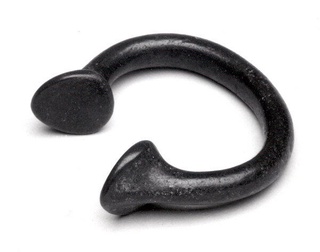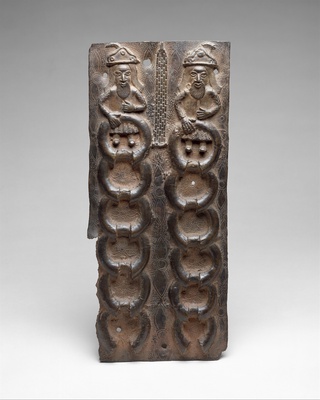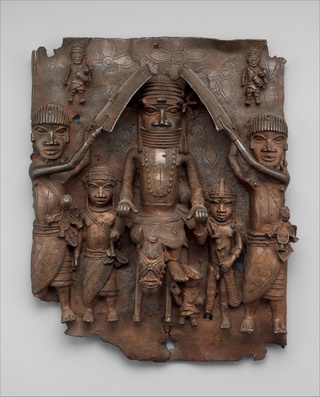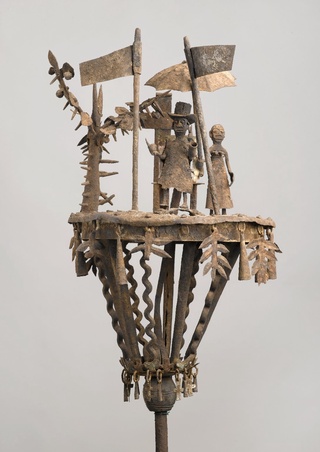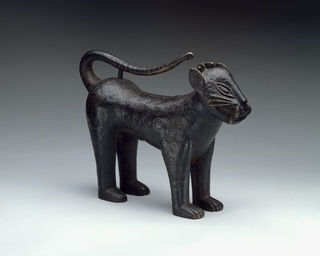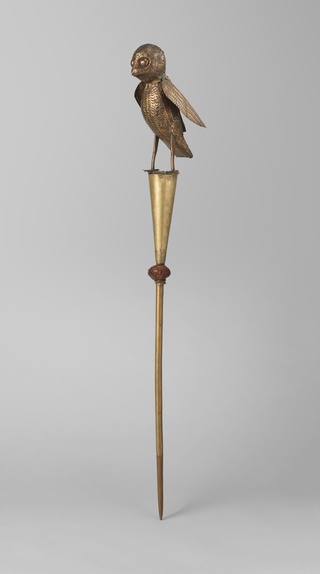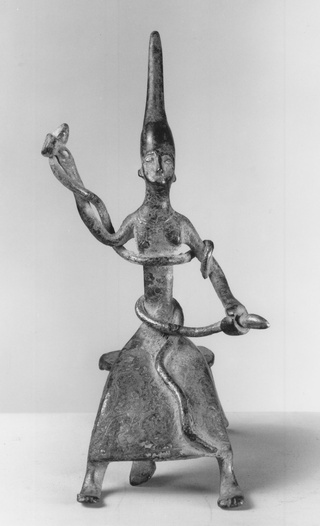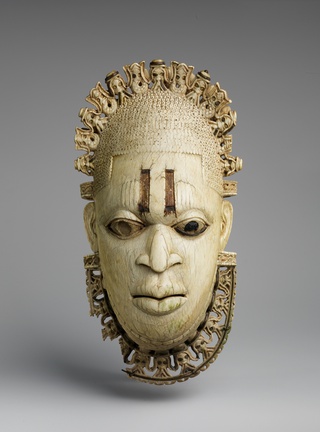Sculptural Symbols of Power in the Kingdoms of Benin and Dahomey
By Colony Little•September 2025•18 Minute Read
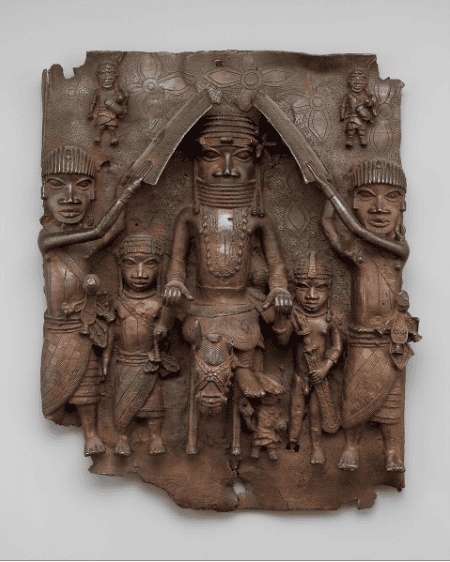
Plaque: Equestrian Oba and Attendants, 1550–1680, Metropolitan Museum of Art. Public Domain.
West African sculptures from the 16th to 19th centuries, made in the Edo Kingdom of Benin (1200-1897) and the Fon Kingdom of Dahomey (1625-1892), were vital symbols of the kingdoms’ wealth and history. While colonial conquest threatened to erase the complicated histories of these two kingdoms, West African movements for repatriation and reparation are ongoing.
Introduction
West African empires have historically used art objects to vaunt their leaders, celebrate prosperity, and memorialize war. Local metalsmiths cast and forged metals including copper and zinc into elaborately designed sculptures, bas relief plaques, royal regalia, and weaponry. These objects were frequently used in performance and ritual.1
In distinct expressions of military might, the West African Edo Kingdom of Benin (located in what is now Nigeria) and Fon Kingdom of Dahomey (located in what is now the country of Benin) both created art to declare their respective power and dominance in the region. As vessels of storytelling, these artifacts also chronicled the historic events that defined each kingdom and characterized the leadership attributes of their rulers.
With their accumulated wealth, sovereign leaders in Benin, called Oba, and kings in Dahomey, known as Ahosu, commissioned artisans to preserve their legacies in sacred objects. West Africa built a robust economy on exporting material goods. Between the 16th and 19th centuries, these profits were overshadowed by those made participating in the transatlantic slave trade with Europeans.
Early trade with the Portuguese expanded West Africa’s access to brass and copper in the 16th century.2 Artisans used these metals to create sculptural artworks in the capitals of Benin City in Benin, and Abomey in Dahomey, continuing a pre-European tradition of local metalworking supplied through this new influx of raw materials from Europe.3
European colonial encroachment in the region culminated with the French destruction of Abomey in 1892. In 1897, the British attacked Benin City, looting thousands of cultural objects and colonizing the kingdom as part of the British Empire.4 These stolen artifacts were surreptitiously acquired by museums and academic institutions and traded among personal collections. Their theft and dispersion adds a patina of colonial rule to their visual history, as calls for their return to their respective homelands raise questions around stewardship, repatriation, and their historical legacies.
Metal and Clay, Embedded with Wealth, Power, and History
Edo histories date the first kingdom of Benin to the first century BCE, with the Obaship emerging in the 13th century.5 By the time the Portuguese began trading with the Oba of Benin in the mid-1400s, the kingdom was well established.6
The Fon formally instituted the historical Kingdom of Dahomey in the 17th century. Dahomey commanded wider power and control in the region after adopting a violent, expansionist policy that involved military conquest of local chiefdoms.7 Twelve officially recognized Ahosu and regents, including Queen Hangbe, successively ruled Dahomey between 1625 and 1900, as recorded by oral histories.8
In both the Kingdoms of Benin and Dahomey, rulers commissioned palace artists to create prestigious and often sacred objects that told local histories.
Metal Trade and Slavery
Metal currency in the form of the horseshoe-shaped bangles called manilla (“igho” in Edo) were traded by the Portuguese—who coveted what they referred to as the Slave Coast’s supply of minerals, spices, ivory, and human labor—as part of the transatlantic slave trade. Beyond its monetary value, manilla was also used by Fon and Edo artisans to create sculptures, extending a West African tradition of metalworking dating to at least the 10th century CE.9 In the Edo Kingdom of Benin, the Oba wielded their power through demonstrations of wealth and prosperity, establishing guilds of artisans who created ancestral objects from igho to commemorate historical events within the Obaship.
While plaques such as those included here, known in Edo as Ama, make up a significant portion of the Benin Bronzes, other revered objects, including masks (referred to as Uhunmwu-Ẹkuẹ and Aro Ododua in Edo), vessels, staffs (Osogan and Ukhurhẹ), and commemorative heads (Uhunmwu Elao), were made from wood, ivory, brass, and other materials.10 These items were integral to the history of the royal court.
Fon metalworkers in the Kingdom of Dahomey made precious sculptures for royal or military rituals. While some metal items were ornamental, many were imbued with a spiritual purpose.11 Artisans also made sculptural figures including staffs that were placed within the royal palace on altars to serve as conduits between the spiritual and physical worlds. Powerful and protective spiritual vessels called bocio were also placed in front of royal shrines.12
Artisans as Storytellers
Abomey, 2006. Wikimedia Commons, user: Joachim Huber, CC BY- SA 2.0. A photograph of the remaining Royal Palaces of Abomey. The original site consisted of 10 palaces built by each successive king to honor their predecessor. The Historical Museum of Abomey is housed in the former palaces of King Guezo and King Glele. https://commons.wikimedia.org/wiki/File:Abomey_2006_1.jpg.
In the royal complex of the Kingdom of Dahomey, palace artisans created polychrome clay bas reliefs commemorating historical moments within the palaces of each king. These earthen reliefs were important tools in Fon storytelling. Some of the reliefs depict battles fought with neighboring groups; they also document early encounters with Europeans that eventually developed into the transatlantic slave trade.
Dahomean rulers consulted Vodun priests in divination ceremonies designed to portend the future and envision the ruler’s reign.13 Each new ruling Ahosu and their royal court would use divination symbols called fa to characterize their specific strengths. Palace artisans designed bocio that embodied the likeness of the king’s fa, and these objects were placed in the Royal Palace and displayed during the coronation period of each new ruler.
Rulers also held annual festivities, known as Huetantu or Xwetanu, where the royal palace would exhibit sculptures, bocio, textiles, and other decorative totems designed to flaunt its riches and military prowess.14 Many of these objects contained symbols which were adopted by each king as emblems of their leadership. These ceremonies often featured spiritual rituals, including mass human sacrifice where the blood of captured rival tribesmen and executed prisoners was poured on the graves of royal ancestors to call upon them for strength and protection in future battles.15 These festivities were designed to rally the kingdom and keep soldiers primed for combat.
Kingship and Strategic Symbolism
In both the historical Kingdoms of Dahomey and Benin, rulers were typically associated with specific symbols, often animals.
In the Benin Kingdom, the three most common symbols of Obaship were the leopard, a symbol of royal power; the mudfish, signifying prosperity and peace; and the ibis, the bird of prophecy.16
Dahomey rose to power through combat and conquest; each king was represented by a unique symbol—usually a zoomorphic figure—that epitomized their leadership attributes.17
Among the many rulers of the Kingdom of Dahomey, the reign of King Guezo in particular sits at the crux of trade, wealth, power, and art. During Guezo’s reign, from 1818 to 1859, he used his royal coffers, which he bolstered through the resurgence of the slave trade, to invest heavily in the arts.18 He officially designated artisans as members of the royal court responsible for cultural stewardship and historical preservation.19
Guezo’s zoomorphic symbols were the elephant and buffalo, which signified the fighting prowess of the kingdom. Another frequently used image for his kingdom was a clay jar with holes that resembled a sieve.20 As a sign of unity, two hands cover the holes as they hold the jar aloft.21
According to oral historians, during his rule, Guezo reengaged a group of female emissaries and palace bodyguards and transformed them into a battalion of soldiers.
Dahomey’s Warrior Women
FORBES (1851) p1.045 A AMAZON IN THE DAHOMEY ARMY - SEH-DONG-HONG-BEH. Wikimedia Commons, user: Metilsteiner. CC-PD. A color illustration of a warrior woman from the Kingdom of Dahomey holding a severed head. These troops were commonly known as “amazons” among European observers. Illustration is from volume 1 of Dahomey and Dahomans by FORBES. https://commons.wikimedia.org/wiki/File:FORBES(1851)_p1.045_A_AMAZON_IN_THE_DAHOMEY_ARMY_-_SEH-DONG-HONG-BEH.jpg
The origin story of the Dahomean army’s all-woman section varies among historians. Known as Agojie in Fon; Mino, which translates to “our mothers”; and Ahosi, which translates to “king’s wives,” they may have originated as a group of hunters called gbeto during the 1600s.22 Others believe that the Mino became soldiers during the short reign of Queen Hangbe in 1708, after the death of her brother King Akaba.23 These women warriors had a reputation as ferocious fighters, possessing the brute strength required for combat while also perfecting the stealth needed for ambushes. Oral histories reflect the increased level of influence these women wielded in the royal palace.
Female officers amazons in Dahomey, 1894. Wikimedia Commons, user: Kjersti Lie, CC-PD. A black and white photograph of a large group of women warriors in Dahomey wearing decorative horns on their head that are believed to denote their rank.
The Agojie’s strength and numbers increased under successive rulers. At their peak, their numbers reached between 4,000 and 6,000 soldiers, roughly one quarter to one third of the kingdom’s total army. During Guezo’s reign, the Agojie trained for heavy combat, wore elaborately designed uniforms, and assumed leadership responsibilities in the royal court.24 Because of their reputation as fierce fighters and their close proximity to power, the Agojie commanded reverence.
Female officers, 1851. Smithsonian Magazine, September 23, 2011, Public Domain. Illustration of two female officers in the Dahomean Army wearing horns on their heads, each carrying a rifle. https://www.smithsonianmag.com/history/dahomeys-women-warriors-88286072/.
The tin horns of the buffalo, King Guezo’s animal symbol, were frequently worn by Agojie. These headdresses were not just decorative, they were symbols of rank as military emblems and service marks for the sovereign.25
Colonialism
Europeans intensified colonial inroads into West Africa in the late 1800s with the British destruction of the Kingdom of Benin and the French siege of Dahomey. As prized possessions of their respective kings, the artworks created in the kingdoms of Dahomey and Benin became prime targets for British and French theft and destruction.
The French Domination of Dahomey
As calls for the end of slavery intensified around the world after Britain abolished slavery in 1807, Dahomey continued to participate in the slave trade for decades. During his reign, Guezo maintained economic interests in slavery while also establishing a lucrative trade in palm oil. Against a backdrop of widespread colonial conflict with European countries in the region, Dahomey also faced battles with local rivals which left Dahomey’s once-powerful army vulnerable to defeat by the French in 1892. France occupied the capital city of Abomey, but not before it was set on fire by King Béhanzin in order to prevent the sacred complex from falling into foreign hands.26
Fabrication de L'huile de Palme, 1895. https://digitalcollections.nypl.org/items/510d47de-0fa6-a3d9-e040-e00a18064a99. The New York Public Library Digital Collections, Public Domain. Illustration of men and women making palm oil in Dahomey. This became a lucrative trade for the kingdom in the early 19th century and especially after England abolished slavery in 1833.
This fire destroyed most of the royal palaces and sacred tombs where artworks were housed. Only a few of the palaces remain. A large-scale preservation effort to restore the remaining earthen reliefs was initiated in the 1990s between the Getty Conservation Institute and the Republic of Benin’s Department of Cultural Patrimony.27
Royal Bas-Reliefs of Abomey, Getty Conservation Institute. “A look at the GCI's project (1992-1997) to systematically document and preserve the polychrome earthen panels (bas-reliefs) at the Royal Palace Museum in Benin, which depict battle scenes and allegorical symbols of the power of the kings of Dahomey. The project also provided local staff with training in conservation, photo documentation, and long-term care of the bas-reliefs.”
The British Colonization of Benin
In 1897, the British launched a violent overthrow of Benin City. Soldiers looted and sold the Oba’s prized bronzes and other sacred objects. Colonial officials and collectors scattered the objects largely in North America and Europe, hiding many away in private collections and locking others up in state museums, where most of them still remain. The plundering of these artifacts by the British has become synonymous with imperialism’s wholesale destruction of life and culture and colonialism’s exploitative tactics of rule.28
The Fate of the Looted Objects
Repatriation demands from Nigeria and Benin to Britain and France dating back decades were met with resistance. Nigeria attempted multiple restitution efforts with Britain beginning in the 1930s through the 1970s, which they revitalized in the early 2000s when the Nigerian sovereign formally issued a memorandum to the British Parliament demanding the return of the bronzes to the Oba.29
Present-day Benin forged a similar request for restitution from France in 2016 that was swiftly denied. The request was revisited again between 2017 and 2018 when a report commissioned by French President Macron determined that over 90 percent of “material cultural heritage” created in the former Slave Coast remained in Western collections.30 This report led to France passing a law in 2020 to return 26 objects looted from the Abomey capital of Dahomey by France in 1892 to Benin.
As demands for the return of these looted objects intensify, African and European countries contend with questions involving logistical oversight and ownership. And ongoing stewardship of the history of these objects demands continued accountability from Western institutions and collections to acknowledge their role in the original theft, dispersal, and acquisition of these artifacts. In July of 2022 the National Commission for Museums and Monuments (NCMM), as part of their decades long repatriation effort, signed an accord with Germany to release 1,130 bronzes held in museums back to Southern Nigeria. At the time of the signing, Germany returned 22 of the bronzes.31 Similar accord agreements prompted the Wereldmuseum in the Netherlands and the Dutch government to agree to return 119 artifacts in February of 2025. The handover to Nigeria, which took place in late June of 2025, represented the largest repatriation effort to date, according to the NCMM’s Director General, Olugbile Holloway. The Horniman Museum in London pledged to return 72 bronzes to Nigeria with plans for them to be housed in the Edo Museum of West African Art; however, an ownership and stewardship tug of war surfaced between the NCMM and the Oba. In February 2025 the two parties agreed that the NCMM will continue to facilitate the logistical transfer of bronzes back to Benin City.32
As institutions slowly execute their restitution efforts, the British Museum, the largest single holder of Benin bronzes, has no concrete strategy for repatriation. Within museums that have avoided or obfuscated the history of their seizure, these bronzes remain separated from their homes and context. Yet their physical return only resolves a partial element of their contested history. In the United States, the Smithsonian’s National Museum of African American History legally transferred ownership of 29 objects in accordance with their NCMM agreement in 2022—their restitution plan included shared stewardship that combines repatriation and improved transparency surrounding their original seizure. Despite this, some of the language pertaining to the museum’s original accession of the Benin bronzes remains oblique: “These objects eventually made their way into museums and private collections around the world.”33 As vessels of memory, these sacred objects deserve an accurate and transparent accounting of their provenance. Their record of ownership must also acknowledge the circumstances surrounding their original theft and dispersal as part of their narrative.
The implications for a complete and thorough accounting of the Kingdoms of Benin and Dahomey, as evidenced through their history-telling artwork, remain fraught. Ultimately, the cultural battle over the scale and scope of repatriation persists. In the meantime, artists and scholars are relying on elements of critical fabulation, a process of reconstituting the archive, to offer an alternative rendering of history. In the 2024 film titled Dahomey, the directors combined documentary footage of the Benin bronzes’ journey from the Musée du Quai Branly-Jacques Chirac in Paris to the presidential palace in Cotonou, Benin. As art handlers crated and transported thrones, bas reliefs, and zoomorphic renditions of kings, the film presented multiple perspectives from Beninese residents, students, and government officials who debated the complicated issues surrounding the theft and repatriation of the bronzes. One compelling expression is the imagined voice of an anonymous artifact known as #26, a sculptural rendering of King Guezo carved in wood, whose final proclamation in the film becomes a promise:
“I will no longer stop at each junction, where my humanity will be challenged. I'll no longer mull over my incarceration in the caverns of the civilized world. I won't ever stop. I never left. I am here. I don't forget.”
Colony Little (she/her/hers) is a Raleigh-based freelance arts writer and the creator of Culture Shock Art, a site dedicated to the synergies among art, music, and design. As a Black woman with familial ties to the South, Little presently writes with a focus on amplifying the artistic voices of Black creators who are influenced by and create work in the American South. Freelance writing credits include ARTnews, ARTS.BLACK, Burnaway, CARLA, INDY Week, Oxford America, Southern Cultures, W Magazine, and Walter Magazine. Little was a 2020 recipient of the Andy Warhol Foundation Arts Writers Grant.
Citations
See, for example, objects with a range of ceremonial and military functions including the Edo Ada (https://digitalbenin.org/eyo-oto/28), Agbada (https://digitalbenin.org/eyo-oto/32), Ebẹn (https://digitalbenin.org/eyo-oto/29) and Umozo/Ọhọ (https://digitalbenin.org/eyo-oto/30). Obobaifo, Elioghosa. “Ẹyo Otọ.” Digital Benin, 7 November 2022, digitalbenin.org/eyo-oto. Accessed 14 July 2025.
Osadolor, Osarhieme Benson. The Military System of Benin c 1440-1897. 2001, p. 87. University of Hamburg, Germany, PhD dissertation. Ediss, Staats- und Universitätsbibliothek Hamburg, https://ediss.sub.uni-hamburg.de/bitstream/ediss/3156/2/Disse.pdf. Accessed 14 July 2025.
Ezra, Kate. Royal Art of Benin: The Perls collection in The Metropolitan Museum of Art. The Metropolitan Museum of Art, 1992, p.27, https://cdn.sanity.io/files/cctd4ker/production/2bd9f92ba47015b8b6178e10908e137e9666bc35.pdf. Accessed 14 July 2025.
Osadolor, p. 236.
Osadolor, p. 14.
Metzig, Gregor M. "Corals, Brass and Firearms. Material Commodities in Cultural Interactions between Edo and Portuguese in Benin around 1500." Material Culture in Modern Diplomacy from the 15th to the 20th Century, edited by Harriet Rudolph and Gregor Metzig, Band 17 from the multivolume European History Yearbook, De Gruyter Oldenbourg, 2016, pp. 29–54, https://doi.org/10.1515/9783110463217-002. Accessed 14 July 2025.
Piqué, Francesca, and Leslie H. Rainer. Palace Sculptures of Abomey: History Told on Walls. The Getty Conservation Institute and the J. Paul Getty Museum, 1999, pp. 9, 13–14, https://www.getty.edu/publications/resources/virtuallibrary/0892365692.pdf. Accessed 14 July 2025.
There was additionally one queen, Hangbe, whose recognition is contested. Some oral histories attribute Hangbe with the founding of the Agojie, or all-women military unit. Hangbe’s descendants still enjoy a traditional position of authority, and some contemporary women in Benin evoke her as a figure of power. See, for example: Ettang, Ifiok, and Valeria Cardi. The Woman King: In the Footsteps of Benin's Tassi Hangbé. BBC News, 14 October 2022, https://www.bbc.com/news/av/world-africa-63258928. Accessed 7 August 2025.
The British Museum, "Benin and the Portuguese," Smarthistory, September 19, 2016, http://www.smarthistory.org/benin-and-the-portuguese/. Accessed 14 July 2025.
The Edo words are from Digital Benin’s Ẹyo Otọ section. “The aim of this space is to display the historical objects with their correct Edo designation, which creates object groups that differ from the current vocabulary used and interpreted by institutions outside of Nigeria,” write the editors. “Ẹyo Otọ is a foundation for further study of these historical objects and their Edo embeddedness. This digital research space is the beginning of a knowledge production involving the determined participation of Edo people in Nigeria and the diaspora.” “Ẹyo Otọ.” Digital Benin, https://digitalbenin.org/eyo-oto. Accessed 2 May 2025.
Blier, Suzanne Preston. African Vodun: Art, Psychology, and Power. University of Chicago Press, 1995, pp. 340–341. Internet Archive, https://archive.org/details/africanvodunartp0000blie/page/340/mode/2up?view=theater&q=silver. Accessed 14 July 2025.
Blier, p. 342.
Symbols of Fon kings were determined in a divination ceremony known as fa, which predicted the nature and character of each king’s reign. For a slightly more elaborate version, see: Clarke, Christina. "Buffalo (Bocio) (Fon peoples)," Smarthistory, 9 October 2016, https://smarthistory.org/buffalo-bocio/. Accessed 14 July 2025.
“During annual festivities called huetantu, these lavish sculptures and textiles were paraded through the capital to celebrate the kingdom's wealth and military might.” “Xwetanu” spelling comes from: Yoder, John C. “Fly and Elephant parties: Political polarization in Dahomey, 1840–1870.” The Journal of African History, vol. 15, no. 3, July 1974, pp. 417–432, https://doi.org/10.1017/S0021853700013566, https://www.cambridge.org/core/journals/journal-of-african-history/article/abs/fly-and-elephant-parties-political-polarization-in-dahomey-18401870/5181B9D988ECF69AAB3545BA3D6BC6F1. Accessed 14 July 2025.
Piqué and Rainier, pp. 11–12.
Edo Artist. “Leopard Aquamanile.” The Metropolitan Museum of Art, https://www.metmuseum.org/art/collection/search/316524. Accessed 14 July 2025.
Piqué and Rainier, p. 26.
There are many different English-language spellings of Guezo. “Guezo” is used here in accordance with the usage in Palace Sculptures of Abomey, a joint publication of the Getty Museum and the Republic of Benin's Ministry of Culture and Communication.
Sherwood, C. “The King’s Dagger.” Warrington Museum and Art Gallery, 9 October 2020, https://wmag.culturewarrington.org/2020/10/09/black-history-month-2020-the-kings-dagger/. See also: https://en.wikipedia.org/wiki/Ghezo. Accessed 14 July 2025.
“Kingdom of Dahomey.” New World Encyclopedia, https://www.newworldencyclopedia.org/entry/Kingdom_of_Dahomey. Accessed 9 August 2022.
Today, the jar is the symbol of the modern nation-state of Benin (historical kingdom of Dahomey). Piqué and Rainier, p. 36.
There is some contention, however, about this origin story. See, for example: Macdonald, Fleur. “The Legend of Benin's Fearless Female Warriors.” BBC Travel, BBC, 27 August 2018, https://www.bbc.com/travel/article/20180826-the-legend-of-benins-fearless-female-warriors. Accessed 9 August 2022. See also: Masioni, Pat, et al. “The Women Soldiers of Dahomey.” United Nations Educational, Scientific and Cultural Organization, 2014, https://unesdoc.unesco.org/ark:/48223/pf0000230934. Accessed 9 August 2022.
“The Legend of Benin's Fearless Female Warriors.” For more on Hangbe (also referred to as Ahangbé) as the potential founder of the agojie, see: Alpern, Stanley B. “On the Origins of the Amazons of Dahomey.” History in Africa, vol. 25, 1998, pp. 9–25. JSTOR, https://doi.org/10.2307/3172178. Accessed 31 July 2025.
Dash, Mike. “Dahomey’s Women Warriors.” Smithsonian Magazine, 23 September 2011, https://www.smithsonianmag.com/history/dahomeys-women-warriors-88286072/. Accessed 15 July 2025.
Piqué and Rainer, pp. 13–14.
Piqué and Rainier, pp. 17–18.
Piqué and Rainer, p. 83.
Indeed, written records from the colonial attackers reveal the intentionality of the palace’s desecration. For example, in a to-do list for Saturday, 20 February, 1897, British colonial official George Le Clerc listed “ju-ju houses to blow down” and “Queen Mother’s house to be burnt.” Hicks, Dan. The Brutish Museums. Pluto Press, 2020, p. 130. Internet Archive, https://archive.org/details/dan-hicks-the-brutish-museums_-the-benin-bronzes-colonial-violence-and-cultural-/page/129/mode/2up. Accessed 15 July 2025.
Zelazko, Alicja. “Benin Bronzes.” Encyclopedia Britannica, 20 June 2025, https://www.britannica.com/art/Benin-Bronzes. Accessed 14 July 2025.
Costa-Kostritsky, Valeria. “Rate of Return–Is France’s Commitment to Restitution Waning?” Apollo Magazine, 4 January 2021, https://apollo-magazine.com/french-restitution-africa-benin-senegal/. Accessed 14 July 2025.
Ahn, Ashley. “Germany returns looted artifacts to Nigeria to rectify a ‘dark colonial history.’” NPR, 21 December 2022, https://www.npr.org/2022/12/21/1144666811/germany-nigeria-returns-benin-bronzes-looted. Accessed 14 July 2025.
Cassaday, Daniel, “Nigeria Works to Reclaim Benin Bronzes, With a Change of Custodian.” ARTnews, 26 February 2025, https://www.artnews.com/art-news/news/nigeria-benin-bronzes-ncmm-oba-1234733527/. Accessed 10 July 2025.
“Benin Bronzes: Ambassadors of the Oba.” National Museum of African Art, Smithsonian, https://africa.si.edu/exhibitions/current-exhibitions/benin-bronzes-ambassadors-of-the-oba/. Accessed 10 July 2025.
Colony Little (she/her/hers) is a Raleigh-based freelance arts writer and the creator of Culture Shock Art, a site dedicated to the synergies among art, music, and design. As a Black woman with familial ties to the South, Little presently writes with a focus on amplifying the artistic voices of Black creators who are influenced by and create work in the American South. Freelance writing credits include ARTnews, ARTS.BLACK, Burnaway, CARLA, INDY Week, Oxford America, Southern Cultures, W Magazine, and Walter Magazine. Little was a 2020 recipient of the Andy Warhol Foundation Arts Writers Grant.
